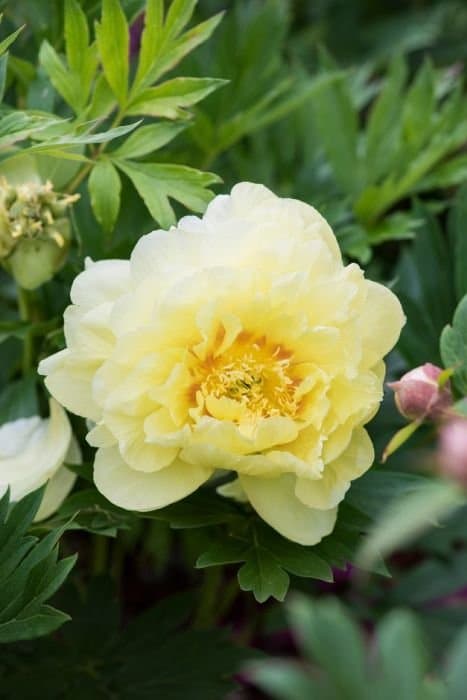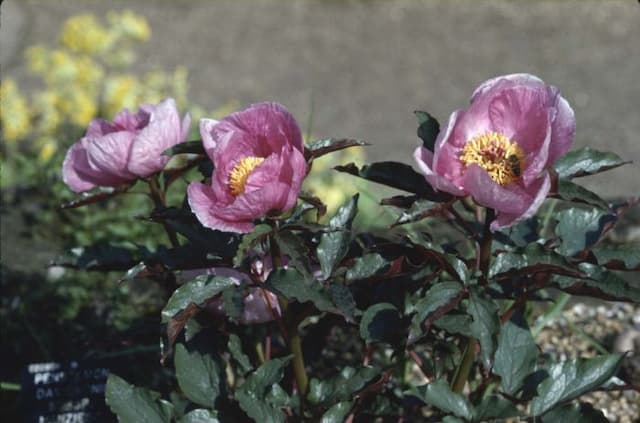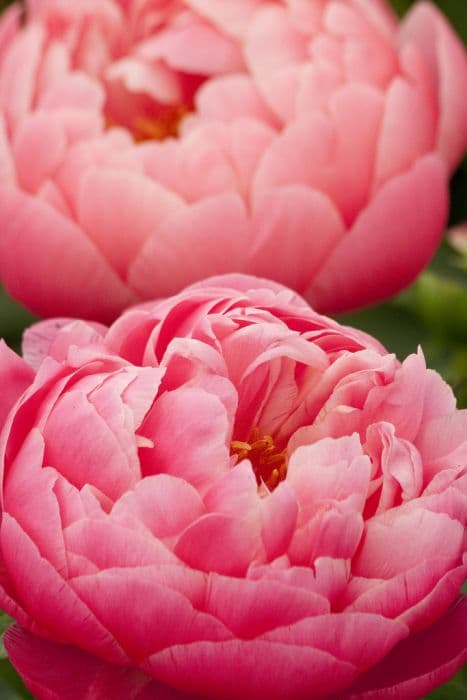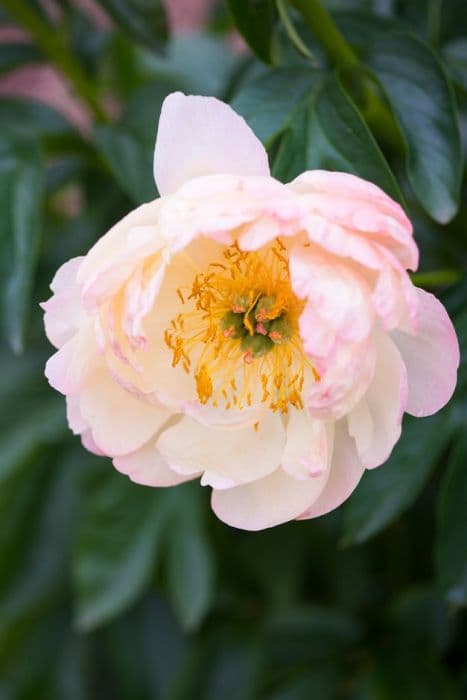Lemoine Peony Paeonia × lemoinei 'Souvenir de Maxime Cornu' (S)

ABOUT
Paeonia × lemoinei 'Souvenir de Maxime Cornu', commonly known as a type of tree peony, is a deciduous shrub known for its captivating and ornamental attributes. This plant boasts large, showy blossoms that are the focal point of their springtime display. The flowers of this particular cultivar have a complex, double-flowered form, presenting a lavish appearance. The petals are abundant and tightly arranged, often with a soft to vibrant pink color that fades to a lighter shade near the petal base. The flower center may exhibit a tuft of yellow stamens, adding contrast and drawing the eye. The blooms exude a subtle fragrance, which adds to their allure. The foliage of 'Souvenir de Maxime Cornu' consists of divided leaves that have a deep green color, providing a lush backdrop for the flowers. These leaves are broadly lance-shaped and may turn an attractive color in the fall before dropping. Overall, the aesthetic of this plant is one of classical beauty, with its exquisite flowers and elegant foliage contributing to its popularity as a garden specimen.
About this plant
 Names
NamesFamily
Paeoniaceae
Synonyms
Lemoine's Peony, Hybrid Peony
Common names
Paeonia × lemoinei 'Souvenir de Maxime Cornu'
 Toxicity
ToxicityTo humans
The plant in question, commonly known as the Lemoine's hybrid peony, is not classified as highly toxic to humans. Ingesting parts of the plant might cause mild stomach upset in some individuals due to its content of glycosides and other compounds, however, severe poisoning is quite rare. It is always advisable to avoid eating ornamental plants and to keep them out of reach of young children who might be tempted to taste them.
To pets
Lemoine's hybrid peony is not known to be significantly toxic to pets. However, as with any non-food plant, ingestion can potentially cause mild gastrointestinal upset, such as vomiting or diarrhea, particularly in dogs and cats with sensitive stomachs. Generally, the plant is not expected to produce serious toxic effects in pets, but it is always wise to monitor your pet's health and consult a veterinarian if any unusual signs occur after ingestion of any plant material.
 Characteristics
CharacteristicsLife cycle
Perennials
Foliage type
Deciduous
Color of leaves
Green
Flower color
Yellow
Height
2-3 feet (60-90 cm)
Spread
2-3 feet (60-90 cm)
Plant type
Shrub
Hardiness zones
4
Native area
Cultivar
Benefits
 General Benefits
General Benefits- Aesthetic Appeal: Adds vibrant color and visual interest to gardens and landscapes with its large, bright flowers.
- Attracts Pollinators: Bees and butterflies are drawn to the flowers, which helps to pollinate other plants in the area.
- Seasonal Interest: Offers a distinct blooming phase in spring or early summer, creating a seasonal focal point.
- Cut Flowers: Blooms are popular for arrangements, providing a long vase life and unique beauty in floral designs.
- Cultural Significance: Has a rich history in gardening and often features in celebrations and traditional events.
- Habitat Support: Provides shelter and nutrients to various organisms, supporting biodiversity.
- Low Maintenance: Once established, it requires minimal care beyond basic watering and occasional feeding.
- Durable: Typically resilient to pests and diseases, reducing the need for chemical treatments.
- Soil Erosion Control: The root system can help stabilize soil, preventing erosion in certain settings.
- Privacy: When planted in groups, can serve as a natural privacy screen due to its size and density.
 Medical Properties
Medical PropertiesThis plant is not used for medical purposes.
 Air-purifying Qualities
Air-purifying QualitiesThis plant is not specifically known for air purifying qualities.
 Other Uses
Other Uses- As a natural dye: The petals of Paeonia × lemoinei can be used to create a natural dye for textiles, providing soft pink to purple hues depending on the mordant used.
- In perfumery: The peony's fragrance may be extracted and used to add sweet floral notes to perfumes and scented products.
- Culinary garnish: The petals are sometimes used as an edible decoration for desserts and salads, introducing a splash of color and a light floral flavor.
- Artistic inspiration: The beauty of Paeonia × lemoinei has inspired artists and photographers who seek to capture the essence of spring and floral elegance.
- Flower arrangements: They are often used in floral decorations and bouquets, particularly in weddings and special events, for their full blooms and lush appearance.
- Botanical studies: The plant can be used for educational purposes in horticulture classes to study hybridization and flower structure.
- Cultural symbol: Peonies often symbolize wealth, honor, and high social status, and are used in cultural events or ceremonies that reflect these values.
- Eco-friendly confetti: Dry peony petals can serve as a biodegradable alternative to traditional paper or plastic confetti at celebrations.
- Photographic subjects: Peonies are commonly used as subjects in macro photography due to their intricate structures and vibrant colors.
- As a natural pest deterrent: While not their primary function, some gardeners plant peonies amongst other plants to help deter certain pests with their fragrance.
Interesting Facts
 Feng Shui
Feng ShuiThe Itoh Peony is not used in Feng Shui practice.
 Zodiac Sign Compitability
Zodiac Sign CompitabilityThe Itoh Peony is not used in astrology practice.
 Plant Symbolism
Plant Symbolism- Prosperity: Peonies like 'Souvenir de Maxime Cornu' are often associated with wealth and success due to their full, round blossoms that symbolize abundance and bounty.
- Romance and Love: With its lush, sumptuous petals, the peony is commonly seen as a symbol of romantic love, often used in weddings and known to represent a happy marriage.
- Honor and High Esteem: The peony's opulent appearance has historically made it a symbol of honor and high esteem, particularly in cultures like China, where it is the national flower.
- Beauty in all Forms: This plant is recognized as a symbol of beauty, encompassing physical, emotional, and spiritual aspects, due to its attractive flowers and overall elegance.
- Good Fortune: Peonies like 'Souvenir de Maxime Cornu' are also considered as a harbinger of good luck, making them a popular gift for a variety of occasions that involve wishing someone well.
- Compassion: Some interpretations attribute peonies, with their nurturing growth and care requirements, as a symbol of compassion and nurturing due to the gardener's attentive role in their cultivation.
 Water
WaterTree Peonies like 'Souvenir de Maxime Cornu' should be watered deeply once a week, providing about 1 inch of water which can be around 0.6 gallons per square yard. This ensures that the water reaches the deep roots. During hot or dry spells, watering frequency should be increased to twice a week. Reduce watering as the fall approaches and the plant prepares for dormancy. Overwatering can lead to root rot, so ensure the soil is well-draining.
 Light
LightTree Peonies such as 'Souvenir de Maxime Cornu' thrive best in full sun to partial shade. They should be planted in a spot that receives at least six hours of sunlight a day for optimal bloom. However, in very hot climates, they benefit from afternoon shade to protect them from scorching.
 Temperature
TemperatureThe 'Souvenir de Maxime Cornu' Tree Peony can withstand temperatures as low as -20°F and as high as 80°F, though it thrives in the cooler end of this range. The plant's ideal growing temperatures are between 50°F and 70°F, as this promotes vigorous growth and flowering. Tree Peonies need a period of winter chill to set buds properly.
 Pruning
PruningFor Tree Peonies such as 'Souvenir de Maxime Cornu,' pruning is necessary to remove dead or damaged wood and to shape the plant. Pruning should be done in early spring before new growth begins. Remove any weak or crossing branches to maintain a healthy framework. Annual pruning helps improve air circulation and encourages strong stems that can support the large flowers.
 Cleaning
CleaningAs needed
 Soil
SoilFor the Tree Peony 'Souvenir de Maxime Cornu', a well-draining soil mix is ideal, comprised of loamy soil enriched with organic matter such as compost or well-rotted manure. The pH should be neutral to slightly alkaline, around 6.5 to 7.5.
 Repotting
RepottingThe Tree Peony 'Souvenir de Maxime Cornu' typically does not need frequent repotting and can thrive in the same spot for years. Only repot if the plant has outgrown its current location or soil conditions have deteriorated.
 Humidity & Misting
Humidity & MistingTree Peony 'Souvenir de Maxime Cornu' prefers average humidity levels and does not require any special humidity conditions. It will do well in the natural outdoor humidity in areas where it can grow.
 Suitable locations
Suitable locationsIndoor
Not ideal for indoors; needs sunlight and space.
Outdoor
Plant in sunny spot, provide well-draining soil, mulch.
Hardiness zone
4-8 USDA
 Life cycle
Life cyclePaeonia x lemoinei 'Souvenir de Maxime Cornu', commonly known as the Itoh peony hybrid, begins its life cycle with seed germination, typically in late winter or spring, developing a root system and sprouting initial leaves. As the plant matures, it forms a bushy clump with strong stems and deeply lobed foliage, entering a vegetative state which can last several years before it is mature enough to flower. Flowering usually occurs in late spring to early summer, showcasing large, showy blooms that range in color from pale yellow to orange, often with a reddish or maroon central fluff. After pollination, if successful, seeds are formed in seed pods that ripen by late summer. Once the flowering and seed setting stages are complete, the plant begins to prepare for dormancy, with foliage dying back in the fall. The plant then remains dormant throughout the winter, conserving energy to restart its life cycle again in the following spring.
 Propogation
PropogationPropogation time
Early spring
Propogation: Paeonia × lemoinei 'Souvenir de Maxime Cornu', more commonly known as peony, is most effectively propagated by division. This is best done in the fall after the plants have gone dormant. To propagate by division, carefully dig up the peony plants, making sure to keep a generous amount of soil around the roots to protect them. Using a sharp garden knife or spade, divide the plant into sections, ensuring that each section has at least three to five eyes, which are the small reddish buds found on the crown of the root. These eyes will become next year's shoots. Replant the divisions promptly at the same depth they were originally growing, spacing them about 3 feet (approximately 0.91 meters) apart to allow for mature growth. Water the new divisions thoroughly to settle the soil and help get them established.









